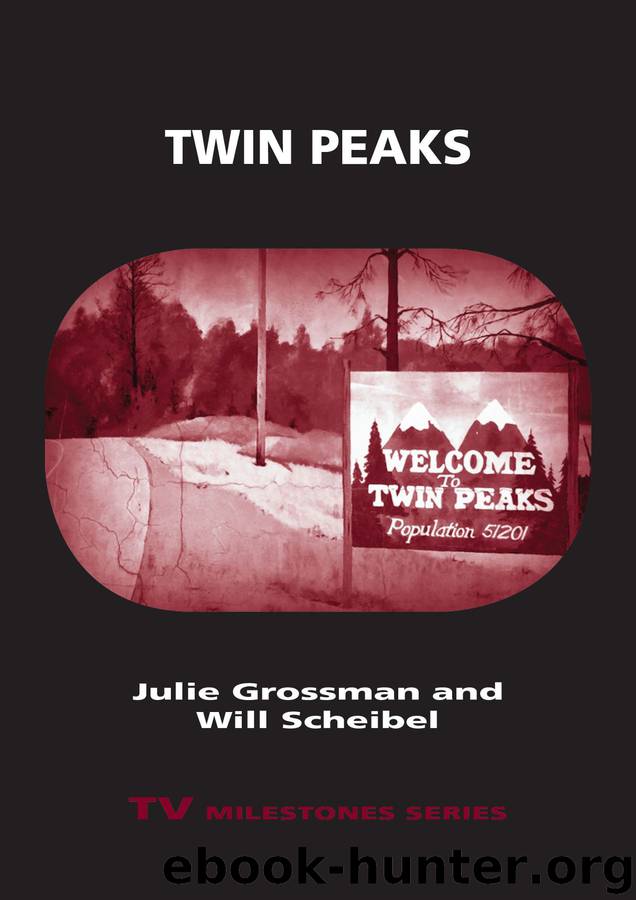Twin Peaks by Grossman Julie; Scheibel Will; & Will Scheibel

Author:Grossman, Julie; Scheibel, Will; & Will Scheibel
Language: eng
Format: epub
Tags: PER010030 Performing Arts / Television / History & Criticism, PER010010 Performing Arts / Television / Direction & Production
Publisher: Wayne State University Press
Published: 2020-02-11T00:00:00+00:00
4
Acting Strangely
Three Performances in Twin Peaks
The deconstructed figure of the femme fatale in Twin Peaks is of interest with respect not only to genre (film noir, specifically) but also to performance. Drawing from sociologist Orrin E. Klapp, Richard Dyer has taught us that a star may personify a “social type,” or “a shared, recognizable, easily grasped image of how people are in society (with collective approval or disapproval built into it)” (47). Twin Peaks is populated largely by US social types, even if some characters ultimately transcend, subvert, or at least problematize the types the series self-consciously deploys. As the previous chapter suggests, the “Independent Woman” emerges as the most recurring type, albeit mystified as the “femme fatale” through the patriarchal fears and desires the series lays bare. But there is also Kyle MacLachlan’s “Good Joe,” Dale Cooper; Dana Ashbrook’s “Tough Guy,” Bobby Briggs; and James Marshall’s “Rebel,” James Hurley, among others. This chapter considers the underexamined relationship between acting and character in Twin Peaks, focusing on three key roles: MacLachlan as Cooper, the Zen FBI special agent from Philadelphia assigned to investigate the murder of high school homecoming queen Laura Palmer; Ray Wise as respected attorney Leland Palmer, Laura’s father, who murders her under the control of the inhabiting spirit BOB, played by Frank Silva; and Sheryl Lee as Laura, a victim of Leland/BOB’s sexual abuse since the age of twelve. Although only glimpsed in the series through flashbacks and Red Room sequences, Laura is the protagonist of the feature film prequel Twin Peaks: Fire Walk with Me. We contend that these performances derive from the intersections of a modernist fragmentation and a melodramatic affect, constituting both the distinctive “strangeness” of the Peaks universe and its earnest appeals to pathos and emotion.
A unifying mode of address through acting would be difficult to establish here, especially given Lynch’s caginess in interviews about his directorial methods and intentions. Moreover, cast members relied on heterogeneous styles, came from various backgrounds, carried different star images, and worked with multiple directors throughout the series (to say nothing of the gap between Twin Peaks and The Return that brought new actors to the series and asked older stars to reprise their roles after twenty-six years). Andreas Halskov comments on the unusual amount of freedom and control Lynch enjoyed in casting Twin Peaks, “using mainly his intuition and his sense of the visual (how a given actor would look on screen)” (64). Lynch “signed actors to nonscripted roles or based on loose ideas he had” (67–68), sometimes inspired by only a head shot (e.g., Sherilyn Fenn as Audrey Horne) or an informal conversation instead of a traditional reading (e.g., James Marshall as James Hurley). Similar to his casting process, Lynch’s work with actors is concerned neither with characters’ “motivation and backstory” nor with “character development and consistency,” as actor Richard Beymer attested in Lynch’s direction of his performance as Ben Horne (68).
Our concerns lie in the individual performances that contribute to the structuring motif of “acting
Download
This site does not store any files on its server. We only index and link to content provided by other sites. Please contact the content providers to delete copyright contents if any and email us, we'll remove relevant links or contents immediately.
| Direction & Production | Genres |
| Guides & Reviews | History & Criticism |
| Reference | Screenwriting |
| Shows |
Head of Drama by Sydney Newman(2025)
Robin by Dave Itzkoff(2012)
I'm Judging You by Luvvie Ajayi(1893)
The Paranormal 13 (13 free books featuring witches, vampires, werewolves, mermaids, psychics, Loki, time travel and more!) by unknow(1850)
Single State of Mind by Andi Dorfman(1516)
Ten by Gretchen McNeil(1502)
#MurderTrending by Gretchen McNeil(1398)
Key to the Sacred Pattern: The Untold Story of Rennes-le-Chateau by Henry Lincoln(1353)
Most Talkative by Andy Cohen(1311)
Merv by Merv Griffin(1268)
This Is Just My Face by Gabourey Sidibe(1181)
Notes from the Upside Down by Guy Adams(1180)
Jamie Oliver by Stafford Hildred(1148)
The Hunger Games: Official Illustrated Movie Companion by Egan Kate(1122)
Springfield Confidential by Mike Reiss(1108)
Clarkson--Look Who's Back by Gwen Russell(1080)
The TV Writer's Workbook: A Creative Approach To Television Scripts by Ellen Sandler(1075)
Blue Planet II by James Honeyborne & Mark Brownlow(1022)
Dark Angel by D. A. Stern(1016)
